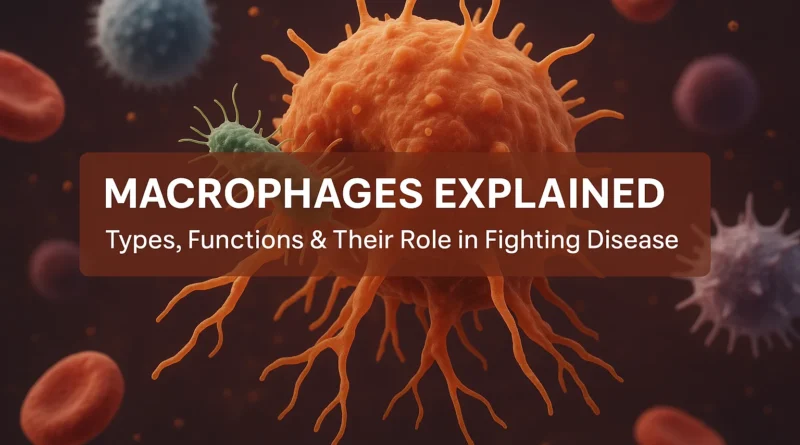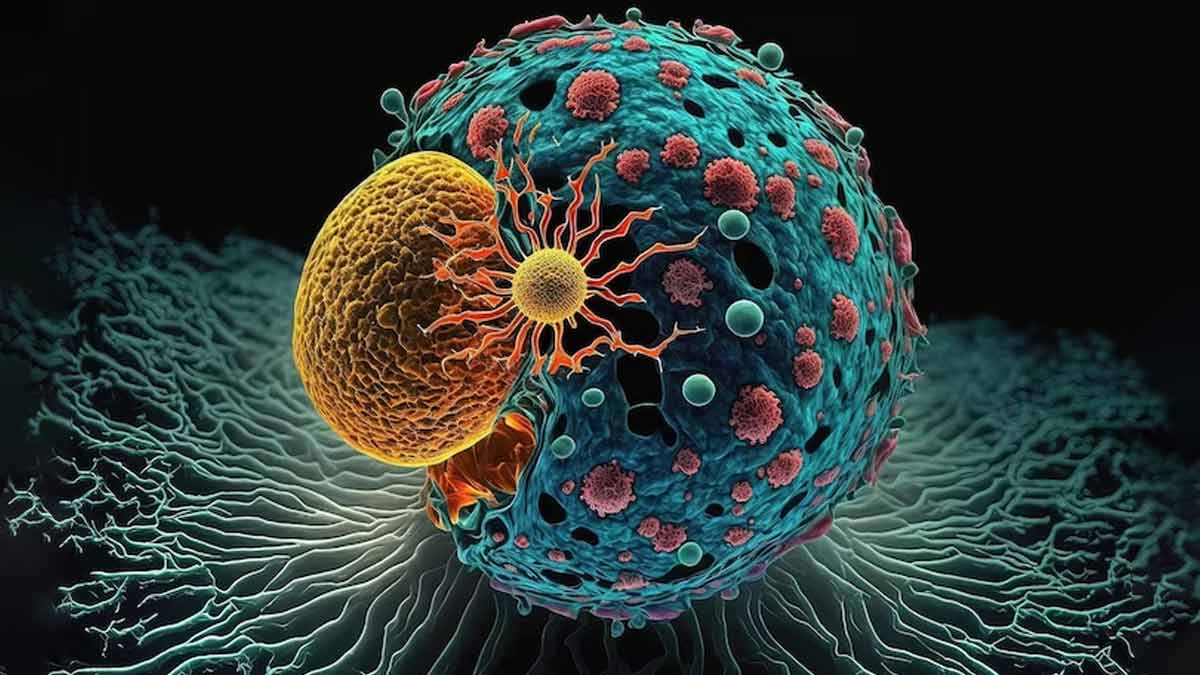Macrophages Explained: Types, Functions & Their Role in Fighting Disease
Macrophages are powerful immune cells that protect the body from infections, kill cancer cells, and maintain tissue health. These specialized white blood cells are a component of the innate immune system and function as the body’s first line of defense. This article will explain macrophages, their various forms and functions, and their vital role in fighting autoimmune disorders, infections, and cancer.
What are macrophages?
Derived from the Greek words “makro” (big) and “phagein” (to eat), Macrophages are specialized white blood cells and a vital component of the immune system found throughout your body. These cells are best known for their ability to “eat” pathogens such as bacteria, viruses, and dead or damaged cells. As part of the immune system, macrophages function as microscopic vacuum cleaners, preserving tissue health and triggering immune responses when pathogens enter our body.
Who discovered Macrophages?
Macrophages were first identified by Russian zoologist Élie Metchnikoff in 1882, who observed these phagocytic cells in the starfish larvae, recognizing their role in engulfing and destroying foreign substances.
His work on understanding the mechanisms of innate immunity earned him a Nobel Prize in 1908 and laid the foundation for modern immunology.
Types of Macrophages
Macrophages’ high degree of adaptability enables them to perform a range of functions based on the tissue they reside in and the signals they receive from their environment. In general, they can be divided into
1. Tissue-Resident Macrophages:
These macrophages reside in specific tissues from birth and play key roles in maintaining homeostasis and immune monitoring. Examples include- Kupffer cells (liver), Alveolar macrophages(lungs), Microglia(brain)
2. Inflammatory Macrophages:
These are also known as classically activated (M1) macrophages. They appear during infections or inflammation. They release pro-inflammatory cytokines and are effective at killing pathogens and cancer cells.
3. Anti-Inflammatory Macrophages:
These are alternatively activated (M2) macrophages that engage in wound healing, tissue repair, and immune regulation. They help suppress inflammation and promote recovery.
Note: The M1/M2 classification is a simplified model. In reality, macrophages vary along a flexible spectrum, adjusting their behavior according to signals from their environment.
3. Specialized macrophages
These are also tissue-resident macrophages, and depending on their location, they are divided into different types, such as
- Kupffer Cells (Liver): found in the liver, specifically in the sinusoids, they help filter blood from the digestive tract, engulf pathogens, dead cells, and toxins. Kupffer cells also help in recycling red blood cells and maintaining liver immunity.
- Alveolar Macrophages (Lungs): They are located in the alveoli (air sacs). They act as the First line of defense against inhaled particles, dust, and microbes. They protect the lungs by phagocytosing (eating) harmful substances and reducing inflammation, which could harm the delicate lung tissue.
- Microglia (Brain): They are present in the brain and spinal cord (part of the CNS) and examine the environment, remove injured neurons and cellular debris, respond to injury or infection, and promote neuroinflammation and brain development.
- Osteoclasts (Bones): They are found on the surface of bone. They function as Multinucleated macrophage-like cells that break down bone tissue, also known as bone resorption. They are necessary for the growth, remodeling, and repair of bones.
- Langerhans Cells (Skin): They are found in the epidermis (outer layer of skin) and act as APCs (antigen-presenting cells). After detecting pathogens, they capture and process antigens, then migrate to lymph nodes to activate T-cells, leading to an immune response.
Key Functions of Macrophages
Macrophages are multipurpose fighters. Here’s a breakdown of their fundamental functions:
- Phagocytosis (Engulfing Pathogens): Phagocytosis, the process by which macrophages engulf bacteria, viruses, dead cells, and debris, is their most well-known function. Once ingested, these particles are broken down by lysosomal enzymes.
- Antigen Presentation: Using MHC (major histocompatibility complex) proteins, macrophages present fragments of the pathogen (antigens) on their surface after engulfing it. By alerting T cells, these initiate the adaptive immune response.
- Production of Cytokines: Macrophages release signaling molecules known as cytokines, such as TNF-α, IL-1, and IL-6, which attract and activate other immune cells to initiate an immune response.
- Tissue Repair and Regeneration: Anti-inflammatory (M2) macrophages release VEGF and TGF-β growth factors to promote angiogenesis (the growth of new blood vessels) and fibrosis (wound healing).
- Immune Surveillance: Even in the absence of infection, macrophages patrol tissues, detecting and removing aging as well as abnormal and cancerous cells.
Role of Macrophages in Fighting Disease
1. Macrophages in Infections
Among the first cells to react to bacterial, viral, or fungal infections are macrophages. They absorb and break down (phagocytose) microorganisms. Produce reactive oxygen species (ROS) and warn other immune cells about the infection site.
In some cases, such as tuberculosis, macrophages attempt to engulf Mycobacterium tuberculosis, but the bacteria may remain alive, leading to chronic infection.
2. Macrophages and Cancer
Tumor-associated macrophages (TAMs): Highly specialized immune cells found within the tumor microenvironment with the ability to both promote and inhibit tumor growth and progression. They affect various processes, including tumor growth, blood vessel formation (angiogenesis), immune regulation, metastasis, and resistance to chemotherapy.
They are classified as
- M1-like TAMs: Attack tumor cells and promote anti-tumor immunity.
- M2-like TAMs: Show pro-tumor activities by promoting tumor growth, suppressing T cells, and helping tumors evade the immune system.
Researchers are looking into immune therapies that can reprogram TAMs to fight cancer.
3. Macrophages in Autoimmune Diseases
In autoimmune diseases such as rheumatoid arthritis and multiple sclerosis, macrophages become overactive, causing inflammation and tissue damage through the release of pro-inflammatory cytokines.
4. Macrophages in Chronic Inflammation
Several metabolic disorders, such as obesity, atherosclerosis, and diabetes, involve macrophage-mediated chronic inflammation. For example:
Involvement in obesity and insulin resistance
Insulin resistance worsens in obesity when macrophages invade adipose tissue and release inflammatory signals. or macrophages engulf cholesterol to become foam cells, this leads to the formation of arterial plaques, causing the arteries to harden and narrow—a condition known as atherosclerosis.”
Therapeutic Applications to Target Macrophages
Macrophages have emerged as promising targets in medicine because of their essential role in disease:
- Cancer therapy: Drugs like CSF-1R inhibitors aim to block M2-like TAMs.
- Immunotherapy: CAR-macrophage (CAR-M) therapy is being developed, similar to CAR-T, to enhance macrophage ability to target tumors.
- Anti-inflammatory drugs: Targeting macrophage-derived cytokines is useful in autoimmune and chronic inflammatory diseases.
- Vaccines: Macrophages act as adjuvants and antigen-presenting cells, boosting vaccine effectiveness.
- Immunotherapy and Drug Delivery: Researchers are focusing on techniques to either activate or suppress macrophages, enhancing their activity to fight cancer and scaling it down to manage autoimmune diseases. They are also used to deliver medications directly to patients.
- Macrophage Reprogramming: New methods attempt to convert “bad” macrophages into “good” ones. This could lead to more effective treatment for cancer and long-term infections.
The Future of Macrophage Research
- Single-cell RNA sequencing: This cutting-edge technology enables researchers to examine individual macrophages and their gene expression in great detail. It demonstrates how unique and dynamic these cells are across tissues and diseases.
- Personalized immune therapies: Future treatments may involve customizing macrophage-based therapies for individual patients based on their immune profiles. This personalized approach holds promise for treating complex diseases more effectively.
Conclusion
Macrophages are vital components of the immune system that support tissue repair, waste removal, infection prevention, and cancer defense. However, when they go wrong, they can cause chronic diseases, autoimmunity, and cancer. In particular, new research is establishing methods to regulate macrophages for inflammatory conditions. These advancements could change how we treat many serious diseases in the future.
People may ask
Can macrophages kill cancer cells?
Yes, especially M1 macrophages can phagocytose cancer cells directly and release inflammatory chemicals that stimulate other immune cells.
Are macrophages part of the innate or adaptive immune system?
Macrophages are a component of the innate immune system, but they also help activate the adaptive immune system by presenting antigens to T cells.
Are macrophages involved in wound healing?
Indeed, M2 macrophages play an important role in wound healing by releasing growth factors that promote tissue repair and reduce inflammation.
How long does a macrophage live?
The lifespan varies according to the function and tissue. While some macrophages in inflammatory sites may only survive a few days, others, like the brain’s microglia, can live for years.
What diseases are linked to macrophage dysfunction?
Chronic infections, autoimmune diseases (such as lupus and rheumatoid arthritis), cancers, and neurodegenerative illnesses like Alzheimer’s are among the many conditions linked to macrophage dysfunction.
What are some natural ways to boost macrophages?
While there is no direct way, you can enhance your immune health through regular exercise, getting enough sleep, eating a healthy, vitamin- and antioxidant-rich diet, and managing stress.
Can macrophages be used in therapy?
Yes. Therapeutic strategies involving macrophages include reprogramming them in cancer, using them in vaccine development, and modulating their activity in inflammatory diseases.




